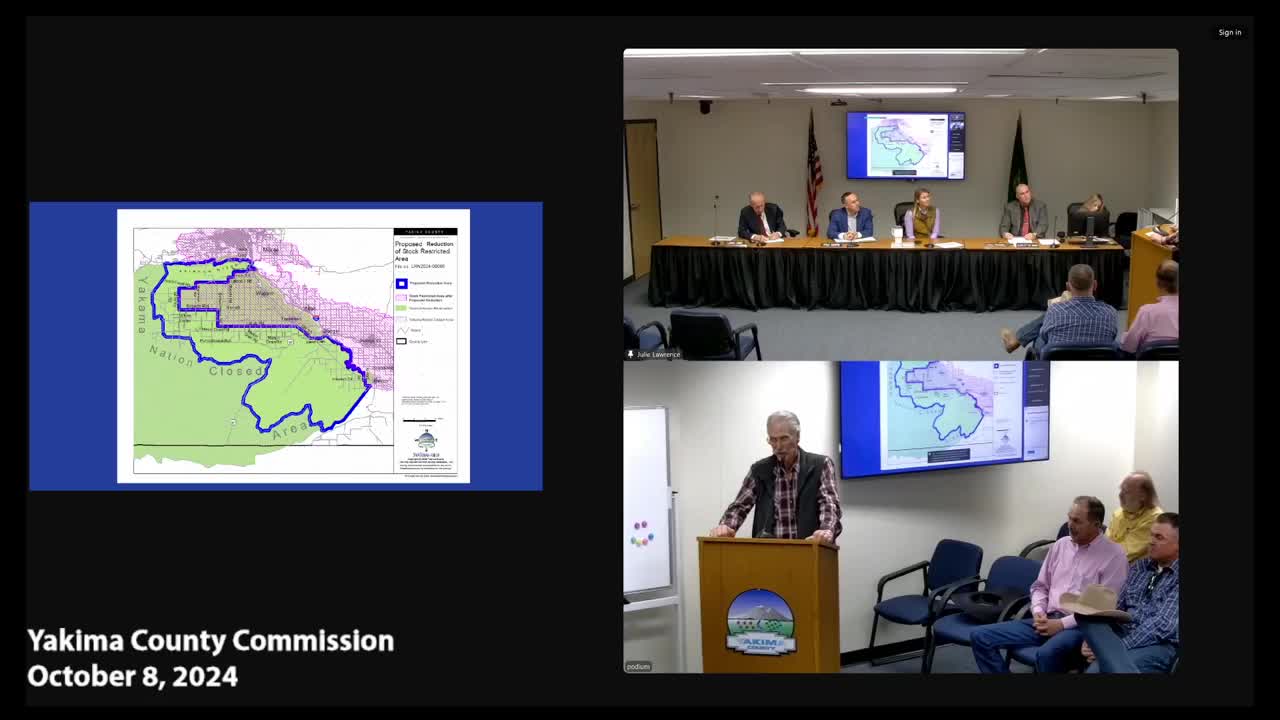Farmers demand urgent action to tackle livestock theft and wild animal threats
October 08, 2024 | Yakima County, Washington
This article was created by AI summarizing key points discussed. AI makes mistakes, so for full details and context, please refer to the video of the full meeting. Please report any errors so we can fix them. Report an error »

During a recent government meeting in Yakima County, local agricultural producers voiced significant concerns regarding livestock management, theft, and wildlife threats. The discussions highlighted the challenges faced by ranchers in the region, particularly in relation to wild animals and the increasing incidents of theft.
Bill Lawrence, a rancher from White Swan, detailed the severe impact of wild dogs, bears, and other predators on his cattle, stating that these animals pose a substantial risk to livestock safety. He also raised alarms about theft, noting that over 50 stolen vehicles had been recovered from his leased lands in the past five years, exacerbating the difficulties ranchers face in securing their properties.
The meeting also addressed the aftermath of a recent wildfire that devastated approximately 31,100 acres, with Lawrence reporting losses of cattle and damage to fencing. He emphasized the need for better protection and support for ranchers, who are often left vulnerable to both natural and human threats.
Mike Tobin, representing the North Yakima Conservation District, echoed these sentiments, advocating for the use of new technologies to enhance livestock management and security. He suggested that returning to original land use boundaries could help mitigate some of the issues ranchers face, allowing for better management of livestock and reducing risks associated with vandalism and theft.
Greg Morton, another local rancher, shared his experiences with property damage caused by vehicles and the challenges of managing livestock in open range conditions. He called for clearer regulations regarding livestock trespassing and the responsibilities of landowners.
The meeting concluded with a commitment to continue discussions on these pressing issues, with officials encouraging further public participation in future hearings. The concerns raised reflect a broader struggle within the agricultural community to maintain viable operations amid increasing threats from wildlife and crime, underscoring the need for collaborative solutions between ranchers, local authorities, and tribal entities.
Bill Lawrence, a rancher from White Swan, detailed the severe impact of wild dogs, bears, and other predators on his cattle, stating that these animals pose a substantial risk to livestock safety. He also raised alarms about theft, noting that over 50 stolen vehicles had been recovered from his leased lands in the past five years, exacerbating the difficulties ranchers face in securing their properties.
The meeting also addressed the aftermath of a recent wildfire that devastated approximately 31,100 acres, with Lawrence reporting losses of cattle and damage to fencing. He emphasized the need for better protection and support for ranchers, who are often left vulnerable to both natural and human threats.
Mike Tobin, representing the North Yakima Conservation District, echoed these sentiments, advocating for the use of new technologies to enhance livestock management and security. He suggested that returning to original land use boundaries could help mitigate some of the issues ranchers face, allowing for better management of livestock and reducing risks associated with vandalism and theft.
Greg Morton, another local rancher, shared his experiences with property damage caused by vehicles and the challenges of managing livestock in open range conditions. He called for clearer regulations regarding livestock trespassing and the responsibilities of landowners.
The meeting concluded with a commitment to continue discussions on these pressing issues, with officials encouraging further public participation in future hearings. The concerns raised reflect a broader struggle within the agricultural community to maintain viable operations amid increasing threats from wildlife and crime, underscoring the need for collaborative solutions between ranchers, local authorities, and tribal entities.
View full meeting
This article is based on a recent meeting—watch the full video and explore the complete transcript for deeper insights into the discussion.
View full meeting
